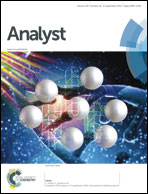Voltammetric pH sensing using carbon electrodes: glassy carbon behaves similarly to EPPG
Abstract
Developing and building on recent work based on a simple sensor for pH determination using unmodified edge plane pyrolytic graphite (EPPG) electrodes, we present a voltammetric method for pH determination using a bare unmodified glassy carbon (GC) electrode. By exploiting the pH sensitive nature of quinones present on carbon edge-plane like sites within the GC, we show how GC electrodes can be used to measure pH. The electro-reduction of surface quinone groups on the glassy carbon electrode was characterised using cyclic voltammetry (CV) and optimised with square-wave voltammetry (SWV) at 298 K and 310 K. At both temperatures, a linear correlation was observed, corresponding to a 2 electron, 2 proton Nernstian response over the aqueous pH range 1.0 to 13.1. As such, unmodified glassy carbon electrodes are seen to be pH dependent, and the Nernstian response suggests its facile use for pH sensing. Given the widespread use of glassy carbon electrodes in electroanalysis, the approach offers a method for the near-simultaneous measurement and monitoring of pH during such analyses.


 Please wait while we load your content...
Please wait while we load your content...